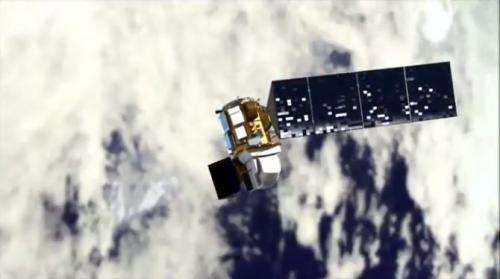Landsat looks to the Moon (w/ Video)

Every full moon, Landsat 8 turns its back on Earth. As the satellite's orbit takes it to the nighttime side of the planet, Landsat 8 pivots to point at the moon. It scans the distant lunar surface multiple times, then flips back around to continue its task of collecting land-cover information of the sunny side of Earth below.
These monthly lunar scans are key to ensuring the land-imaging instrument aboard Landsat 8 is detecting light consistently. For this, engineers need a consistent source of light to measure. And while there are some spots on Earth – like the Sahara Desert or other arid sites – that reflect a relatively stable amount of light, nothing on our planet beats the moon, which lacks an atmosphere and has an unchanging surface, barring the odd meteorite.
We really wanted something we could trust for Landsat 8," said Brian Markham, leader of the calibration team for Landsat 8, which was built and launched by NASA and is now operated by the U.S. Geological Survey. "We do have Earth sites we look at for calibration. But the precision with which you can track things by using the Earth, because of the atmosphere, is not as good as the moon."
Landsat 8's Operational Land Imager, or OLI, collects information on the visible, near infrared and shortwave-infrared light reflecting off Earth's surface. Each wavelength of light provides information about the ground surface below. OLI has 14 detector modules, each of which contains hundreds of individual detectors that record different spectral bands. The calibration team at Goddard and the U.S. Geological Survey's EROS facility in South Dakota is tasked with making sure each of those detectors register light consistently over time.
Aboard the spacecraft, lamps provide light to calibrate OLl's detectors, but the lamps aren't perfect. On the Landsat 7 satellite, the lamps started to fade before the detectors did. Another option, solar diffusers, which use indirect sunlight, can darken as well.
"Everything else we've tried to use to monitor the stability of our instruments has often not been as good as the instruments themselves," Markham said. But the moon is a steady, not-too-bright light in the sky. "As long as we know what its illumination conditions are, we can trend our instrument performance to it because we trust its stability."
So Landsat 8 planners designed this latest satellite to image the moon as a baseline calibration. If, during these lunar tests, the OLI detectors indicate that the moon is getting slightly duller or brighter, then the Goddard scientists will know the instrument –not the moon – is off. With that data, they can adjust the algorithms that calculate land cover information during Landsat's regular Earth-observation orbits.
It's a fairly complicated operation to scan the moon each month, said Susan Good, a flight dynamics engineer at Goddard who works with Landsat 8.
"There are 14 detector modules," Good said, "each of these has to scan the same path along the moon, so that you collect exactly the same data on each sensor."
The flight dynamics software determines precisely where the spacecraft will need to point during a lunar calibration. The timing is set for just after the moon is completely full. Then, as Landsat 8 passes over Antarctica and heads north in Earth's shadow, the spacecraft maneuvers to the precise location to start the first scan across the lunar surface.
It executes tiny and precise scans to take seven or eight passes across the moon – each one angled so that a different detector is centered on the moon. This takes about 18 minutes, by which time the spacecraft has almost reached the Arctic. So it maneuvers back to point at Earth, and complete its day-lit imaging. Then, Landsat 8 pivots to face the moon again, completing additional passes to test the remaining detectors. After two orbits, the lunar calibration is complete.
In Landsat 8's first year, the lunar calibration tests show that the detectors are stable, Markham said, within a fraction of a percent. If the lunar calibrations and other tests show the detectors are off, the scientists can adjust the calculations that turn the raw Landsat data into information on land cover brightness, maintaining their accuracy.
Since the regular checks on Landsat 8's performance, Good jokes that she will never look at the full moon the same. "I think oh, we're having a lunar calibration," she said. "I always know what Landsat' 8's doing when the moon is full."
Provided by NASA's Goddard Space Flight Center




















